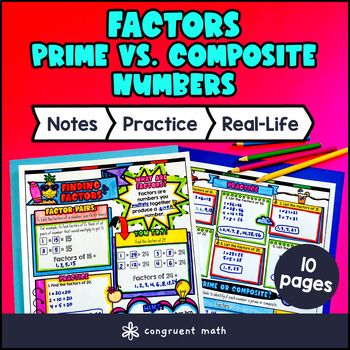Want more ideas and freebies?
Get my free resource library with digital & print activities—plus tips over email.
Join for Free Resources →
$4.25
Ever wondered how to teach factors and prime vs. composite numbers in an engaging way to your 4th grade students?
In this lesson plan, students will learn about factor pairs and how to identify prime and composite numbers through artistic, interactive guided notes, checks for understanding, a maze activity, and practice worksheets. These activities help build a clear and fun understanding of factors within the range of 1-100.
The lesson concludes with a real-life example that explores how factors apply to inventory management, showing students the practical use of math in everyday situations.

$4.25
After this lesson, students will be able to:
Before this lesson, students should be familiar with:
As a hook, ask students if they have ever tried to arrange objects in equal groups, like setting the table with matching plates and utensils or organizing pencils into small bundles. How do they figure out how many groups or pairs they can make without anything left over? Refer to the last page of the guided notes for real-life examples such as inventory management as well as the FAQs below for additional ideas and prompts.
Use the first page of the guided notes to introduce what factors are. Walk through the definition of a factor as a number that divides another number exactly, and explain how to find factor pairs of whole numbers between 1 and 100. Guide students in seeing that factor pairs multiply together to get the original number, and model finding factor pairs for example numbers like 12 and 24. Refer to the FAQ below for detailed explanations of these concepts and suggestions for addressing common student questions about factor pairs and divisibility.
Use the second page of the guided notes to give students practice on solving for factor pairs. Then, review prime and composite numbers, linking this concept to factors. Highlight that prime numbers have exactly two factors—1 and itself—and composite numbers have more than two factors. Use example numbers like 7 (prime) and 8 (composite) to demonstrate identifying factors and classifying numbers. Encourage students to check factor pairs carefully to determine whether a number is prime or composite. Refer to the FAQ below for a step-by-step walkthrough and ideas on clarifying misconceptions related to prime versus composite numbers.
Based on student responses during the guided notes and embedded comprehension checks, reteach any concepts students find challenging, such as recognizing all factor pairs or distinguishing prime from composite numbers. If your class includes a wide range of proficiency levels, consider pulling out small groups or individual students needing extra support for targeted reteaching. Meanwhile, encourage more advanced students to begin attempting the practice exercises to reinforce their understanding independently.
Have students practice finding factor pairs and identifying prime versus composite numbers using th maze worksheets activity (page 3) included in the guided notes. Walk around to answer student questions.
Fast finishers can start the color by number activity (page 4) for extra practice. You can assign it as homework for the remainder of the class.
Using the last page of the guided notes, bring the class back together, and introduce the concept of inventory management, showing how understanding factors helps businesses organize products efficiently by grouping items into equal bundles or boxes. Discuss how knowing whether a number is prime or composite can affect packaging decisions or storage arrangements. Refer to the FAQ for more ideas on how to teach it!
If you’re looking for digital practice for factors, prime, and composite numbers, try my Pixel Art activities in Google Sheets. Every answer is automatically checked, and correct answers unlock parts of a mystery picture. It’s incredibly fun, and a powerful tool for differentiation.
Here’s 2 activities to explore:
A factor is a number that divides another number evenly without leaving a remainder. For example, factors of 12 include 1, 2, 3, 4, 6, and 12.
To find all factors of a number, divide the number by integers from 1 up to itself and look for those with zero remainder.
Steps:
Factor pairs are two numbers that multiply together to give the original number. Every factor has a pair. For example, the factor pairs of 12 are (1, 12), (2, 6), and (3, 4).
A prime number is a whole number greater than 1 that has only two factors: 1 and itself. For example, 2, 3, 5, and 7 are prime numbers.
A composite number is a whole number greater than 1 that has more than two factors. For example, 4, 6, 8, and 9 are composite because they have factors besides 1 and themselves.
To determine if a number is prime or composite:
Steps:
Understanding factors helps in many areas of math because factors are the building blocks of numbers.
Benefits:
Factors appear in many everyday situations.
Examples:
Get my free resource library with digital & print activities—plus tips over email.
Join for Free Resources →